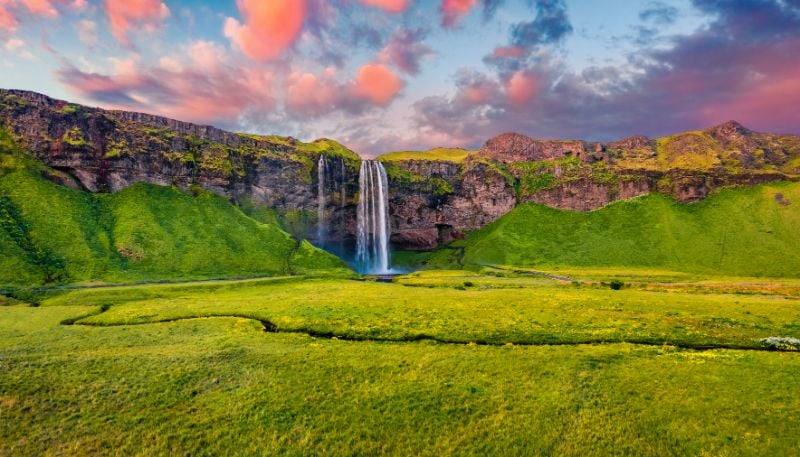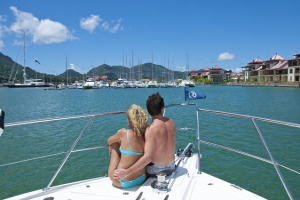1. Gullfoss

Gullfoss translates to Golden Falls, which is how the Golden Circle earned its name. “Foss” is Icelandic for “waterfall,” so you’ll see that word a lot while you’re visiting Iceland.
Gullfoss waterfall is one of the most famous cascades in Iceland. This is largely due to how close it is and how easily accessible it is from Reykjavik.
It’s one of the main sights on the Golden Circle route and a must-see attraction for anyone visiting Iceland. A Golden Circle tour will take you to this popular waterfall, or you could drive yourself.
The two-tiered waterfall clocks in at 105 feet and is accessible year-round. If you’re visiting Gullfoss (or any of these waterfalls) in the winter, bringing along crampons will make for a much less slippery experience. There is a gift shop, a restaurant, and restrooms available here, plus plenty of viewing points.
2. Oxararfoss
Oxararfoss is a hidden gem within Thingvellir National Park. Surprisingly, it’s also one of the rare man-made waterfalls in Iceland! Trust me, it’s equally impressive and worth the short hike from the parking lot to see it.
The waterfall is fed by the Oxara River and cascades over the Almannagja Gorge 44 feet into a pool surrounded by rocks. It’s not uncommon for this waterfall to completely freeze over during the winter months. This makes for some spectacular photography!
Even though all of the Golden Circle tours will take you to Thingvellir National Park, you most likely will not have enough time to hike to this majestic waterfall. Save this one for a self-drive tour so you can take your time.
3. Seljalandsfoss

You’ve probably seen photos of Seljalandsfoss Waterfall; it is one of the most photographed waterfalls in Iceland. It’s also one of the few waterfalls that you can walk behind!
Seljalandsfoss is located in South Iceland. It’s almost always a stop on a South Coast tour, and depending on what time of year you visit, you may be able to walk behind it. When I visited Iceland in February, it was too icy, but I received redemption when I returned in November. Just look at that view!
Seljalandsfoss is one of Iceland’s tallest waterfalls. This beautiful waterfall drops 197 feet! If you do plan on walking behind it, make sure you’re wearing waterproof clothes. You will get wet.
4. Skógafoss

Skogafoss is not far from Seljalandsfoss and also is a popular stop for folks cruising down the South Coast. Skogafoss is slightly taller than Seljalanadsfoss, clocking in at 200 feet with a width of 82 feet. Due to the constant spray, it’s not uncommon to see rainbows at this spectacular waterfall.
Although you can’t walk behind it, you can walk right up to it. Prepare to get drenched if you do! There is also an option to climb some (500+) steps and get a bird’s eye view of Skogafoss.
5. Selfoss

Selfoss is a waterfall in North Iceland located in the Jökulsárgljúfur canyon. Don’t confuse this waterfall with the town by the same name that’s in southern Iceland; they’re on opposite sides of the country!
Selfoss may not be the tallest waterfall in Iceland, but its 36-foot falls are nothing short of impressive. If its height doesn’t wow you, its width will. Selfoss is 330 feet wide!
Selfoss often gets overshadowed by its nearby neighbor, Dettifoss. Many of the Diamond Circle tours from Akureyri will stop here since it is less than a mile away from Dettifoss.
6. Hafragilsfoss
Dettifoss, Selfoss, and Hafragilsfoss are all located in Vatnajökull National Park. They are all located on the Jökulsá á Fjöllum River, and it’s pretty easy to knock out all three in an afternoon.
If you’re doing a self-drive tour, I’d recommend spending a night in Mývatn. It’ll put you in a great spot to see all three of these falls, plus many other highlights in Northeast Iceland.
Hafragilsfoss is a single-drop waterfall with a width of 300 feet that drops 89 feet into Jokulsargljufur Canyon. Surrounded by towering cliffs, this hidden gem offers spectacular views. Because it tends to get outshined by Dettifoss, you might find you have this waterfall all to yourself!
See Related: Silfra Rift and Fissure in Iceland: Where East and West Meet
7. Dettifoss

Europe’s most powerful waterfall is a sight to be seen. Dettifoss is one of the most popular attractions in North Iceland, and it’s a regular stop along the Diamond Circle.
Like Hafragilsfoss, Dettifoss is fed by the glacier river Jökulsá á Fjöllum. This stunning waterfall clocks in at 330 feet wide with a 150-foot drop into Jökulsárgljúfur Canyon.
If you’re visiting Iceland during the summer months you’ll be able to walk right up to Dettifoss and feel its thunderous power shake the earth. You’ll still have a great view in the winter, but icy conditions may prevent you from getting as close as you’d like.
8. Godafoss
Godafoss is my favorite waterfall in Iceland. It’s located in northeastern Iceland, not too far away from Akureyri. Its dreamy blue water and otherworldly surrounding landscape easily make this one of the most enchanting places I’ve ever been.
The “Waterfall of the Gods,” earned its name after one of the most pivotal points in Iceland’s history. By 1000AD, pressure from Norway was rising to push Pagan Icelanders to Christianity. Lawspeaker Thorgeir Ljosvetningagodi was tasked with deciding whether Iceland would change its official religion.
As the legend goes, Thorgeir announced that Christianity would be the official religion, but Pagans would be allowed to practice their beliefs in private. In a symbolic gesture, he threw his idols of the Old Gods into the waterfall. Godafoss clocks in at 100 feet wide with a 39-foot drop into a picturesque pool that’s a Caribbean blue.
9. Hengifoss

You’ll find Hengifoss sitting pretty over in East Iceland. Clocking in at 420 feet, Hengifoss is the third-tallest waterfall in Iceland and is one of the most spectacular waterfalls on this side of the country.
The hike to Hengifoss is one of the most popular hiking trails in East Iceland. From the parking lot, it’s about a 50-minute hike, so plan accordingly! Because of the lengthy hike, this is a great waterfall to visit on a self-drive tour.
When you arrive at the waterfall, you’ll be met with magical surroundings. Hengifoss is surrounded by layers of basaltic strata with thin, red layers of red clay between them. Geologists have even found fossilized trees in these layers, suggesting much warmer climates at one point.
10. Kirkjufellsfoss
Oh, Kirkjufellsfoss. Where do we begin?
Game of Thrones fans will instantly recognize this famous waterfall in Iceland. With Mt. Kirkjufell in the background, this might just be the most photographed spot in Iceland.
Because of its fame, expect a lot of tourists when you visit these famous falls. The walk from the parking lot is less than five minutes, but it can be pretty icy in the winter, so please be careful!
You’ll find it on the northern side of Snaefellsnes. Most day tours to the Snaefellsnes Peninsula will stop here.
11. Bruarfoss

You’ll find this beautiful waterfall right off the Golden Circle in southwest Iceland. Brúarfoss is only about 20 minutes from Gullfoss, so you can easily fit this into your own Golden Circle adventure.
Brúarfoss means “bridge waterfall” and was named for a stone archway that once crossed over the river. It crumbled over a century ago, but the waterfall is still thriving. This unique waterfall is fed from a glacial water river, which is what gives this impressive waterfall its glacier-blue color.
12. Svartifoss

Surrounded by hexagonal basalt columns, Svartifoss is one of the most beautiful places I’ve ever seen. Located in Skaftafell in Vatnajökull National Park, this waterfall in southeastern Iceland cascades 65 feet.
It may be one of the smaller waterfalls on this list, but the journey to view it is well worth your time. The two-mile out-and-back trail to Svartifoss is moderately difficult and mostly uphill on the way there.
There are a few other waterfalls along the way: Magnúsarfoss, Hundafoss, and Þjófafoss, which can be viewed from the trail. Four waterfalls in one hike sounds like a good deal, right? You could easily spend 2-4 hours in this area, so make sure you’ve got plenty of daylight before you hit this trail.
13. Dynjandi

Dynjandi is the largest waterfall in the Westfjords of Iceland. Also known as Fjallfoss, this bridal veil waterfall has a drop of 326 feet and is almost 100 feet wide at the top and almost 200 feet wide at the bottom.
The hiking trail to Dynjandi is about a mile long and moderately challenging. There are six other waterfalls you’ll pass on the way to Dynjandi, which is quite the bargain for a mile-long hike!
“Dynjandi” means “thunderous,” and you’ll be able to hear this mighty waterfall long before you see it. When you get up to it, you’ll be amazed at this incredible display of power.
See Related: Best Hotels in Iceland for Northern Lights
14. Glymur
Glymur Waterfall is the second-tallest waterfall in Iceland, and boy, it is a beauty! You’ll find this massive 650-foot waterfall in Hvalfjordur, just 30 minutes from Reykjavik. Glymur got its name from an old Iceland legend.
As the story goes, a man was turned into a whale by an elf woman after he betrayed her (seems legit). Naturally, the man was rather annoyed with his transformation and sank a boat in the nearby Hvalfjordur fjord, killing two men who were the sons of the local priest.
The priest lured the whale up the river, where he crashed into the canyon, forming the waterfall Glymur. “Glymur” means a “loud, echoing rumble,” and it is believed to be the sound the whale made when he crashed into the canyon.
The hike to Iceland’s second-tallest waterfall is nothing short of sensational. It takes about 3.5 hours, and the journey is just as incredible as the destination.
You’ll be hiking through lava caves, crossing rivers, and more. For this reason, this is one waterfall you’ll want to visit during the summer months. Guided hikes to Glymur are offered from June to August.
15. Haifoss

Háifoss is the fourth-largest waterfall in Iceland. Located in south Iceland, you get the bonus of seeing two waterfalls when you visit this one! “Granni,” which translates to “neighbor,” is right beside Háifoss.
Another neighbor to these waterfalls is Hekla, one of the most explosive volcanoes in Iceland. It has erupted more than 20 times since 1210.
The most recent eruption was in 2000. Not surprisingly, this volcano has been given the nickname “The Gateway to Hell.”
You’ll need a four-wheel-drive vehicle to reach Háifoss. It’s located on a gravel road just off the main road (Ring Road).
The hike is just shy of three miles and moderately challenging. This is another waterfall best viewed in the summer months.
16. Morsárfoss
Until fairly recently, it was widely believed that Glymur was Iceland’s tallest waterfall. In 2007, Morsárjökull glacier (an outlet glacier of Vatnajökull glacier) began to melt, and new waterfalls were formed.
Morsárfoss was one of them. It’s about 790 feet tall and proudly claims the current title of being the tallest waterfall in Iceland. Sorry, Glymur!
Morsárfoss is surrounded by many other waterfalls, with glacial ice surrounding the waterfall from both the top and the bottom. This is a tricky one to access, and you’ll need a skilled guide.
To reach Morsárfoss, you’ll need to hike over a moving glacier. That means you’ll need all sorts of safety gear, including crampons and ice axes, and you’ll need to wear a harness with a lifeline. It’s certainly not the easiest waterfall to access, but those who do are met with some of the most picturesque cascades in Iceland.
17. Hraunfossar
This one is another twofer. Also known as Lava Falls, the Hraunfossar waterfall and its neighbor Barnafoss, aka Children’s Falls, are two of my favorites.
Famous for their turquoise blue waters, these mesmerizing falls are surrounded by a lava field, and it just makes for an overall surreal view. There’s a pathway that will take you to both Barnafoss and Hraunfossar from the parking lot.
The ice-blue water was certainly memorable, but what bumped these dramatic waterfalls to the top of my list was how walkable they were. There’s a bridge you can cross and plenty of areas to wander along the lava rocks.
There’s also a restaurant here where you can grab lunch, coffee, snacks, etc. Try the soup!
18. Klifbrekkufoss

Klifbrekkufoss is a waterfall in East Iceland famous for its seven tiers. The seven-drop waterfall is a hidden gem for those exploring the Eastfjords.
This legendary cascade is in good company, too. It’s part of the group of some of the tallest waterfalls in the country. Klifbrekkufoss clocks in at 295 feet when you combine each tier.
You’ll find this one in the small village of Mjoifjordur (seriously, the town has a population of fewer than 20 people). Plan to spend the night in Egilsstadir if you’re on a self-drive tour.
While it may be one of the most impressive, it’s also one of the least accessible waterfalls in Iceland – only accessible during summer. Seeing this gigantic waterfall surrounded by all of Iceland’s lush greenery is worth the wait.
19. Aldeyjarfoss

Tucked away in the Northern Highlands along the Skjálfandafljót River, this is another waterfall that’s best visited in the summer. At only 65 feet, it’s certainly not the biggest waterfall in Iceland, but Aldeyjarfoss is absolutely one of the most beautiful waterfalls in Iceland.
Surrounded by towering basalt columns, the waterfall cascades down into a beautiful blue lagoon for an iconic Icelandic sight. Aldeyjarfoss, Godafoss, and Hrafnabjargafoss are three waterfalls in Northern Iceland that can all be seen in one day; just make sure you have a 4X4 vehicle. They’re all fed by the same tumultuous river.
20. Kvernufoss

Kvernufoss is one of the least-visited waterfalls in Iceland, despite being located right next to one of Iceland’s most popular places. The 98-foot waterfall is a true hidden gem along the South Coast, and if you’re visiting Skógafoss, you can easily fit this one into your itinerary.
The hike takes about 20 minutes and starts from the Skógasafn Museum. If you’re visiting in the summer, you’ll have the chance to walk behind it.
Don’t get this one confused with Kvernárfoss in Snaefellsnes Peninsula. The Icelandic language can be tricky, and they are spelled very similarly, but they are on different sides of the country.
See Related: How to Book Cheap Flights to Iceland: A Guide To Direct Flights
21. Hrafnabjargafoss

Hrafnabjargafoss, which translates to “Raven Cliff Falls,” is an impressive horseshoe-shaped waterfall in Northern Iceland. Few people visit it, so you may find you have it all to yourself!
This hidden waterfall is worth your while if you’re planning to visit Adleyjarfoss and Godafoss. They’re all fed by the Skjálfandafljót River and very close to one another. You will need a 4X4 vehicle to get to Hrafnabjargafoss, but the hike from the parking lot is short and sweet.
Related Resources
- About the Author
- Latest Posts
Jacks is a New Orleans native passionate about exploring the Arctic region. She’s a frequent writer and contributor to Only in Your State. A mediocre ukulele player, photographer, and artist, she thrives on spontaneous solo adventures and encourages everyone to follow the deal, not the destination. When she’s not traveling, she’s feeding the neighborhood crows, squirrels, and bluejays that have befriended her, much to the dismay of her cat, Tugger.




